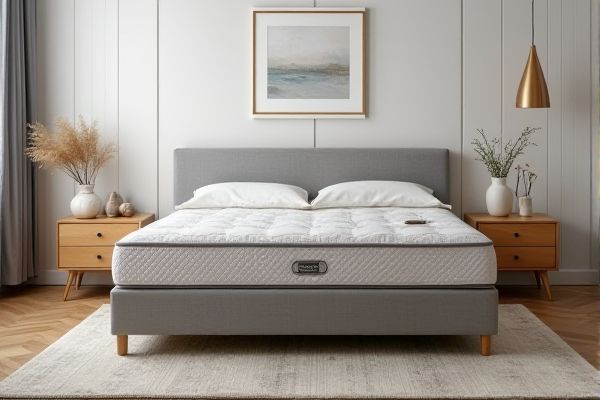
Choosing between a box spring and a slatted base impacts your mattress support and comfort, with box springs offering sturdy shock absorption and slatted bases providing enhanced airflow and flexibility. Explore the benefits and drawbacks of each to determine which base best suits Your sleeping preferences and ensures a restful night. Read on to discover more detailed comparisons and expert recommendations.
Table of Comparison
| Feature | Box Spring | Slatted Base |
|---|---|---|
| Structure | Wooden frame with springs inside | Wooden or metal slats spaced evenly |
| Support | Provides flexible, shock-absorbing support | Offers firm, stable mattress support |
| Compatibility | Best for innerspring mattresses | Works with memory foam, latex, and hybrid mattresses |
| Durability | Less durable due to spring wear | More durable with replaceable slats |
| Ventilation | Limited air circulation | Excellent airflow for mattress breathability |
| Cost | Typically higher price | Generally more affordable |
| Weight | Heavier and less portable | Lightweight and easier to move |
Introduction to Box Springs and Slatted Bases
Box springs consist of a sturdy wooden frame filled with springs, providing enhanced support and shock absorption to extend mattress durability. Slatted bases feature closely spaced wooden or metal slats that offer flexible and breathable mattress support, promoting air circulation and reducing moisture buildup. Choosing the right foundation can improve your sleep quality by aligning mattress performance with personal comfort preferences.
What is a Box Spring?
A box spring is a sturdy wooden frame covered in fabric and containing springs designed to support a mattress by absorbing shock and increasing durability. It provides a flat and firm foundation that enhances mattress ventilation and overall comfort. Unlike slatted bases, box springs distribute weight more evenly, reducing wear and promoting longevity for different types of mattresses.
What is a Slatted Base?
A slatted base consists of evenly spaced wooden or metal slats that support your mattress by providing flexibility and ventilation. Unlike a box spring, which uses a solid frame with springs for cushioning, a slatted base enhances airflow, reducing moisture buildup and extending mattress lifespan. Your choice of a slatted base can improve comfort and maintain optimal mattress hygiene through effective breathability and support.
Key Differences Between Box Springs and Slatted Bases
Box springs consist of a wooden frame covered in fabric and filled with springs, designed to absorb shock and increase mattress longevity, while slatted bases feature a series of wooden or metal slats that offer firm support and improved ventilation. Box springs provide cushioning and height, enhancing comfort for softer mattresses, whereas slatted bases contribute to mattress flexibility and breathability, ideal for memory foam or latex. Your choice between the two depends on the mattress type, desired support level, and overall sleeping comfort preferences.
Mattress Compatibility: Box Spring vs Slatted Base
Box springs provide a sturdy, shock-absorbing foundation ideal for innerspring mattresses, enhancing support and extending mattress life. Slatted bases, featuring spaced wooden slats, offer better ventilation and flexibility, making them suitable for memory foam and latex mattresses. Your choice affects mattress performance, comfort, and durability based on the foundation's compatibility with mattress type.
Pros and Cons of Box Springs
Box springs provide excellent shock absorption and support for mattresses, prolonging their lifespan and enhancing comfort. They typically offer better height elevation, making it easier to get in and out of bed, but they can be bulkier and less ventilated compared to slatted bases. The reduced airflow within box springs may increase the risk of mold and allergens, which requires careful maintenance and a well-ventilated bedroom environment.
Pros and Cons of Slatted Bases
Slatted bases offer excellent ventilation, promoting mattress breathability and preventing moisture buildup, which extends mattress lifespan. Their flexibility provides ergonomic support by adapting to body weight, enhancing comfort and spinal alignment. However, slatted bases may lack durability if the slats are too thin or spaced too far apart, potentially causing sagging and reduced mattress support over time.
Durability and Support Comparison
Box springs offer enhanced durability by evenly distributing weight and absorbing shock, making them ideal for heavy mattresses and long-term use. Slatted bases provide customizable support and improved ventilation, but their durability depends on the quality and spacing of the slats. Choosing the right base affects your mattress's lifespan and comfort, so consider the specific support and durability needs of your sleeping style.
Price and Value Considerations
Box springs typically cost more than slatted bases due to their robust construction and additional materials, often ranging from $150 to $400, while slatted bases are generally more affordable, priced between $50 and $200. The higher price of box springs often reflects enhanced durability and better support for innerspring mattresses, which may provide greater value over time for users seeking long-term comfort. Slatted bases offer customizable support with adjustable slats and are cost-effective, making them a practical choice for budget-conscious buyers prioritizing flexibility and ventilation.
Choosing the Best Base for Your Mattress
Choosing the best base for your mattress depends on factors like support, ventilation, and mattress type. Box springs provide sturdy, shock-absorbing support ideal for innerspring mattresses, while slatted bases offer better airflow and flexibility, perfect for memory foam or latex mattresses. Assess your mattress's requirements and sleeping preferences to ensure your base enhances durability and comfort.
 homyna.com
homyna.com